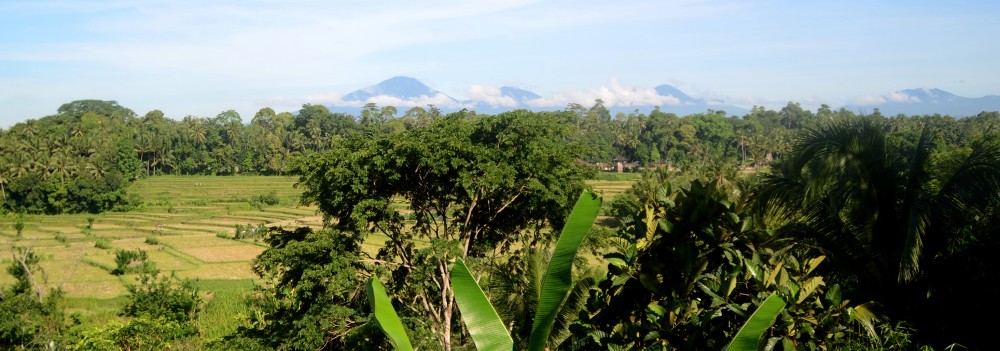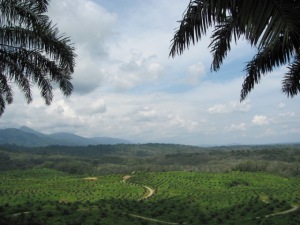Our final day in Indonesia.
We started the day off with our shoes off at the headquarters of AMAN (Aliansi Masyarakan Adat), the alliance of indigenous peoples and forest communities for Indonesia. We sat on the floor drinking tea, eating gooey rice-based treats, and discussing the roles of the various indigenous populations in lobbying for their rights and for the rights of the environment. The discussion was led by Abdon Nababan (try to say that 10 times fast), the head of AMAN, and his enthusiastic team, filled with representatives from all corners of this far reaching country.
Indonesia, a country with over 17,000 islands and a list of 365 ethnic or sub-ethnic groups recognized by the government (to say the least) is fairly diverse. AMAN, founded in 1999, represents over 2000 of these communities and consists of 20 chapters, summing up in total somewhere between 13 and 15 million in population. AMAN works with these communities in a number of facets that include political lobbying, economic development, cultural preservation, and integrated education. All of which are fascinating and we could have spent a day discussing each topic in length, but given the nature of our course (i.e. Socio-Ecological Systems), our topic of conversation generally focused on land use, property rights, and their relation to the indigenous populations.
As a Westerner, something that I (and no doubt others) take for granted is the notion of property rights. We take our wooden pegs, stake out a plot, exchange some currency, and there you have it, we own land. However, the rest of the world doesn’t necessarily view property in this way. To the indigenous of these islands, at least historically, it seems silly. How can you own something that was there before you arrived? This is something that we all share; this is common. In fact, according to Abdon, the indigenous believed that the land was owned by their ancestors, so if you wanted to own land you’d have to die first. But as the story goes, some white people showed up, wreaked havoc on indigenous societies, and eventually they were kicked out, but not before leaving behind a mess of the place. The end result? The government has a system of property ownership that the people who actually live there don’t necessarily follow.
Given all of that, one of the more recent objectives of AMAN is to use participatory mapping to compile a working database registry of indigenous territory. The way that land is currently distributed among the country is that if it isn’t privately owned, then it automatically falls under the jurisdiction of the Ministry of Forestry. The problem is that nobody owns indigenous lands. Approximately 70 percent of land is State owned. Communal land and customary rights are not recognized by the government, making property rights a fairly contentious issue. This makes the Ministry of Forestry one of the most powerful institutions in Indonesia. Other Ministries, such as the Ministry of Mining or the Ministry of Plantations, need permission from the Ministry of Forestry before moving forward on many of their projects. And not only that, but this immense power makes the institution susceptible to bribes and abuses of power. Perhaps that is why we are seeing a growing number of money-generating oil palm plantations scarring the landscape of these small islands.
That takes us to the second half of our day, where we transitioned from the floor of AMAN to the stark executive office of the National Council on Climate Change. There we had the great fortune to speak with first Agus Purnomo, Indonesia’s chief climate change negotiator, and then the Secretary of Mitigation, Farhan Helmy. Among other things, we continued the discussion of land use and property rights, but this time from the perspective of the government. Land use is of importance in mitigating climate change because the primary contributor for climate change in Indonesia is deforestation caused by logging and oil palm plantations. The challenges that they primarily encounter seem to be in obtaining consistent, measurable, verifiable, and reportable data. This data is used for the mapping project on which AMAN has been working and only just recently incorporated into a larger proposal for a one map policy for Indonesia.
Indonesia is known as one of the leaders in pushing for a global climate change initiative and even hosted the United Nations Framework Convention on Climate Change (UNFCCC) in 2007 where they lobbied for recognition of indigenous rights within the UNFCCC. So it comes as a bit of a shock to see how the indigenous are currently neglected within the nation’s own borders. It is nice to see the efforts put forth by NGOs such as AMAN and by governmental institutions such as the National Council on Climate Change, but there is still much work that needs to be done in order to ensure that the rights of the indigenous are protected and not sold off to the highest bidder.
If there is one thing that we have learned from our trip abroad it is that there consistently seems to be too many different organizations and institutions that have their hands in the pot and have a say on what’s going on. The push for decentralization has gone too far and is too mismatched. If there could be more coordination between organizations, such as the one between AMAN and the National Council on Climate Change, perhaps more direct and effective action could take place.
– Cara

